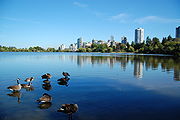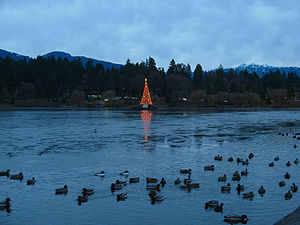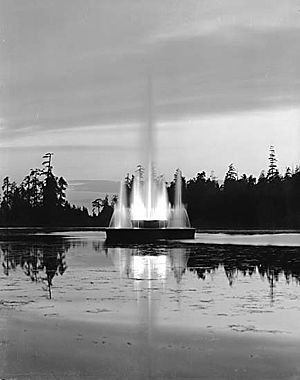
Lost Lagoon
Encyclopedia





Georgia Street
Georgia Street is an east-west street in the cities of Vancouver and Burnaby, British Columbia, Canada. Its section in Downtown Vancouver, designated West Georgia Street, serves as one of the primary streets for the financial and central business districts, and is the major transportation corridor...
, near the entrance to Stanley Park
Stanley Park
Stanley Park is a 404.9 hectare urban park bordering downtown Vancouver, British Columbia, Canada. It was opened in 1888 by David Oppenheimer in the name of Lord Stanley of Preston, the Governor-General of Canada....
in Vancouver
Vancouver
Vancouver is a coastal seaport city on the mainland of British Columbia, Canada. It is the hub of Greater Vancouver, which, with over 2.3 million residents, is the third most populous metropolitan area in the country,...
, Canada
Canada
Canada is a North American country consisting of ten provinces and three territories. Located in the northern part of the continent, it extends from the Atlantic Ocean in the east to the Pacific Ocean in the west, and northward into the Arctic Ocean...
. Surrounding the lake is a 1.75 km (1.1 mi) trail, and it features a lit fountain that was erected by Robert Harold Williams to commemorate the city's golden jubilee. It is a nesting ground to many species of birds, including non-native Mute Swan
Mute Swan
The Mute Swan is a species of swan, and thus a member of the duck, goose and swan family Anatidae. It is native to much of Europe and Asia, and the far north of Africa. It is also an introduced species in North America, Australasia and southern Africa. The name 'mute' derives from it being less...
(whose wing tendons have been clipped to prevent escaping), Canada geese, numerous species of duck
Duck
Duck is the common name for a large number of species in the Anatidae family of birds, which also includes swans and geese. The ducks are divided among several subfamilies in the Anatidae family; they do not represent a monophyletic group but a form taxon, since swans and geese are not considered...
s such as mallard ducks and Great Blue Heron
Great Blue Heron
The Great Blue Heron is a large wading bird in the heron family Ardeidae, common near the shores of open water and in wetlands over most of North and Central America as well as the West Indies and the Galápagos Islands. It is a rare vagrant to Europe, with records from Spain, the Azores and England...
s.
Naming and history
Native food gatherers used the low tide mudflats as a source for clams, and a middenMidden
A midden, is an old dump for domestic waste which may consist of animal bone, human excrement, botanical material, vermin, shells, sherds, lithics , and other artifacts and ecofacts associated with past human occupation...
on the north side indicates that a large dwelling once stood there. In the Sḵwxwú7mesh language, the name is Ch'ekxwa'7lech, meaning "gets dry at times". Settlers also built cabins around the lake, which were all removed between 1913 and 1916 during construction of the causeway.The lake was created in 1916 by the construction of the Stanley Park causeway; until then, Lost Lagoon was a shallow part of Coal Harbour, which itself is an extension of Burrard Inlet
Burrard Inlet
Burrard Inlet is a relatively shallow-sided coastal fjord in southwestern British Columbia, Canada. Formed during the last Ice Age, it separates the City of Vancouver and the rest of the low-lying Burrard Peninsula from the slopes of the North Shore Mountains, home to the communities of West...
.
The name for Lost Lagoon comes from a poem written by Pauline Johnson
Pauline Johnson
Emily Pauline Johnson , commonly known as E. Pauline Johnson or just Pauline Johnson, was a Canadian writer and performer popular in the late 19th century...
, who later explained her inspiration:
- "I have always resented that jarring unattractive name [Coal Harbour] for years. When I first plied paddle across the gunwhale of a light canoe and idled about the margin, I named the sheltered little cove Lost Lagoon. This was just to please my own fancy for, as that perfect summer month drifted on, the ever restless tides left the harbor devoid of any water at my favorite conoeing hour and my pet idling place was lost for many days; hence my fancy to call it Lost Lagoon."
The lake was officially named Lost Lagoon in 1922 by the park board, long after Johnson's death and, ironically, after the lagoon had been permanently lost after becoming landlocked.
Development
When the causeway was first proposed in 1909, an intense public debate took place over the fate of the basin. As with most of the early controversies concerning the use of Stanley Park, organized labour was pitted against the more upper and middle class proponents of the City Beautiful movement. Trade union representatives argued that the majority working class population was in need of recreational facilities, while their opponents maintained that more aesthetic or ethereal considerations should take precedence in park development. The Vancouver Trades and Labour Council was adamantly opposed to the idea of an artificial lake, and argued for it to instead be filled in for use as a sports field. The park board retained the services of T. Mawson and Associates, an architectural landscaping firm that had designed the park's zoo and many other facilities in Stanley Park. The proposal the board settled on featured an artificial lake with a sports stadium on the northwest side and a large museum on the southwest shore. The $800,000 price tag, however, proved too steep for the board's budget, and the non-lake parts of the proposal were quashed.The next phase in the lake's development came in 1929, when the saltwater pipes entering from Coal Harbour were shut off, turning it into a freshwater lake. The BC Fish and Game Protection Association was given permission to stock the lake with trout. The Stanley Park Flyfishing Association was formed, and charged members to fish in the lake, while the park board profited from the canoe and boat rentals. This came to an end in 1938 when the walkway around the lake was constructed and the area declared a bird sanctuary. Civic budgets were significantly reduced during the depression
Great Depression in Canada
Canada was hit hard by the Great Depression. Between 1929 and 1939, the gross national product dropped 40% . Unemployment reached 27% at the depth of the Depression in 1933...
, but the park board benefited from the free labour of relief recipients, who were used to landscape Lost Lagoon.
The next controversy surrounding the lake followed the proposal for a fountain to be erected in the lake to coincide with the city's Golden Jubilee anniversary celebrations in 1936. For the mayor, it would be "a miracle of engineering," with the spray of water lit by virtually "limitless combinations" of colour. The public, in contrast, were not impressed by the proposal. Its $33,019.96 price tag was considered extremely frivolous in the midst of an economic crisis. As written in The Sunday Sun Edition of the Vancouver Sun Newspaper, Saturday, August 8. 1936. The lead story in the Magazine section is; SECRETS OF THE FOUNTAIN. It was the conception and idea of then, Chief Electrical Engineer, Robert Harold Williams with Hume and Rumble Ltd. electrical contractors. R.Harold Williams designed and supervised the erection of the Vancouver's Golden Jubilee fountain. After a business trip to Los Angeles he saw a fountain and thought this would be a great gift for the city for their up and coming birthday, Golden Jubilee celebration. To build the fountain, Lost Lagoon was drained. Seventy piles were driven into the mud. On these a concrete mat was laid. The fountain was built upon this mat. The work was of necessity rushed; it was done in a month. "The fountain is worthy of all the traditions of art, worthy of Vancouver's Golden Jubilee, and it will be a permanent, decorative joy in Stanley Park". "When operating , it is like a symphony concert, in motion and color instead of music, says Harold Williams, engineer, of Hume & Rumble Ltd., under whose personal supervision the work has been done." Vancouver's Jubilee Committee and private citizens who contributed are to be commended on their work in pushing for this beautiful fountain, which is sure to be one of the major attractions during the Golden Jubilee celebration. "We've had to hurry," says Mr. Williams," in that time 285 tons of cement have been utilized and all the special equipment was built." All equipment was built in Canada and the pumps were constructed in Vancouver. All union labor was employed. It was restored for Expo
Expo 86
The 1986 World Exposition on Transportation and Communication, or simply Expo '86, was a World's Fair held in Vancouver, British Columbia, Canada from Friday, May 2 until Monday, October 13, 1986...
in 1986.
Lost Lagoon is a popular place for park users for strolling the perimeter trail and bird watching. On the southeast corner of the lake is the Lost Lagoon Nature House, an old boathouse that is now an interpretive centre for the Stanley Park Ecology Society. While rare in recent decades, Lost Lagoon can freeze during a cold spell, permitting public ice skating
Ice skating
Ice skating is moving on ice by using ice skates. It can be done for a variety of reasons, including leisure, traveling, and various sports. Ice skating occurs both on specially prepared indoor and outdoor tracks, as well as on naturally occurring bodies of frozen water, such as lakes and...
and ice hockey
Ice hockey
Ice hockey, often referred to as hockey, is a team sport played on ice, in which skaters use wooden or composite sticks to shoot a hard rubber puck into their opponent's net. The game is played between two teams of six players each. Five members of each team skate up and down the ice trying to take...
.

